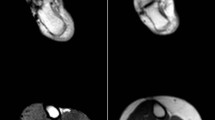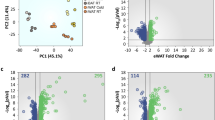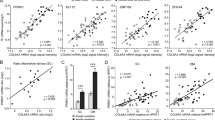Abstract
Objective:
The aim of this study was to establish the time-course of molecular events in intrascapular brown adipose tissue (iBAT) during the development of diet-induced obesity using microarrays and molecular network analysis.
Design:
C57BL/6J male inbred mice were fed a high-fat diet (HFD) or normal diet (ND) and killed at multiple time-points over 24 weeks.
Methods:
Global transcriptional changes in iBAT were determined by time-course microarrays of pooled RNA (n=6, pools per time-point) at 2, 4, 8, 20 and 24 weeks using Illumina MouseWG-6 v2.0 Beadchips. Molecular networks were constructed using the Ingenuity knowledgebase based on differentially expressed genes at each time-point.
Results:
Body weight and subcutaneous adipose were progressively increased over 24 weeks, whereas iBAT was significantly increased between 6 and 12 weeks in HFD-fed C57BL/6J mice compared with controls. Blood glucose and insulin levels were increased between 16 and 24 weeks. Time-course microarrays, revealed 155 differentially expressed genes at one or more time-points over 24 weeks in the iBAT of HFD-fed mice compared with controls. Time-course network analysis revealed a network of skeletal muscle development genes that was activated between 2 and 4 weeks, subsequently a network of immune trafficking genes was activated at 8 weeks. After 20 and 24 weeks, multiple lipid metabolism and immune response networks were activated. Several target genes identified by time-course microarrays were independently validated using RT-qPCR. Tnnc1 was upregulated early between 2 and 4 weeks, later Cd68 and Col1a1 were upregulated between 20 and 24 weeks, whereas 11β-hydroxysteroid dehydrogenase (Hsd11b1) was consistently downregulated during the development of diet-induced obesity.
Conclusion:
Molecular networks in iBAT are modulated in a time-dependent manner in response to a HFD. A broad range of gene targets exists to alter molecular changes within iBAT during the development of diet-induced obesity.
This is a preview of subscription content, access via your institution
Access options
Subscribe to this journal
Receive 12 print issues and online access
$259.00 per year
only $21.58 per issue
Buy this article
- Purchase on Springer Link
- Instant access to full article PDF
Prices may be subject to local taxes which are calculated during checkout



Similar content being viewed by others
References
Finucane MM, Stevens GA, Cowan MJ, Danaei G, Lin JK, Paciorek CJ et al. National, regional, and global trends in body-mass index since 1980: systematic analysis of health examination surveys and epidemiological studies with 960 country-years and 9·1 million participants. Lancet 2011; 377: 557–567.
Guh DP, Zhang W, Bansback N, Amarsi Z, Birmingham CL, Anis AH . The incidence of co-morbidities related to obesity and overweight: a systematic review and meta-analysis. BMC Public Health 2009; 9: 88.
Cannon B, Nedergaard J . Brown adipose tissue: function and physiological significance. Physiol Rev 2004; 84: 277–359.
Nedergaard J, Bengtsson T, Cannon B . Three years with adult human brown adipose tissue. Ann N Y Acad Sci 2010; 1212: E20–E36.
Cypess AM, Lehman S, Williams G, Tal I, Rodman D, Goldfine AB et al. Identification and importance of brown adipose tissue in adult humans. N Engl J Med 2009; 360: 1509–1517.
Pfannenberg C, Werner MK, Ripkens S, Stef I, Deckert A, Schmadl M et al. Impact of age on the relationships of brown adipose tissue with sex and adiposity in humans. Diabetes 2010; 59: 1789–1793.
Wang Q, Zhang M, Ning G, Gu W, Su T, Xu M et al. Brown adipose tissue in humans is activated by elevated plasma catecholamines levels and is inversely related to central obesity. PloS One 2011; 6: e21006.
Vijgen GHEJ Bouvy ND, Teule GJJ, Brans B, Schrauwen P, van Marken Lichtenbelt WD . Brown adipose tissue in morbidly obese subjects. PloS One 2011; 6: e17247.
Mercer SW, Trayhurn P . Effect of high fat diets on energy balance and thermogenesis in brown adipose tissue of lean and genetically obese ob/ob mice. J Nutr 1987; 117: 2147–2153.
Tulp OL, Frink R, Danforth E . Effect of cafeteria feeding on brown and white adipose tissue cellularity, thermogenesis, and body composition in rats. J Nutr 1982; 112: 2250–2260.
Schmid GM, Converset V, Walter N, Sennitt MV, Leung K-Y, Byers H et al. Effect of high-fat diet on the expression of proteins in muscle, adipose tissues, and liver of C57BL/6 mice. Proteomics 2004; 4: 2270–2282.
Fitzgibbons TP, Kogan S, Aouadi M, Hendricks GM, Straubhaar J, Czech MP . Similarity of mouse perivascular and brown adipose tissues and their resistance to diet-induced inflammation. Am J Physiol Heart Circ Physiol 2011; 301: H1425–1437.
Hamann A, Flier JS, Lowell BB . Decreased brown fat markedly enhances susceptibility to diet-induced obesity, diabetes, and hyperlipidemia. Endocrinology 1996; 137: 21–29.
Bachman ES, Dhillon H, Zhang C-Y, Cinti S, Bianco AC, Kobilka BK et al. betaAR signaling required for diet-induced thermogenesis and obesity resistance. Science 2002; 297: 843–845.
Calvano SE, Xiao W, Richards DR, Felciano RM, Baker HV, Cho RJ et al. A network-based analysis of systemic inflammation in humans. Nature 2005; 437: 1032–1037.
Oh H-Y, Shin S-K, Heo H-S, Ahn J-S, Kwon E-Y, Park JHY et al. Time-dependent network analysis reveals molecular targets underlying the development of diet-induced obesity and non-alcoholic steatohepatitis. Genes Nutr 2013. e--pub ahead of print 13 November 2012; doi:10.1007/s12263-012-0322-6.
Baranova A, Schlauch K, Elariny H, Jarrar M, Bennett C, Nugent C et al. Gene expression patterns in hepatic tissue and visceral adipose tissue of patients with non-alcoholic fatty liver disease. Obes Surg 2007; 17: 1111–1118.
Do G-M, Oh HY, Kwon E-Y, Cho Y-Y, Shin S-K, Park H-J et al. Long-term adaptation of global transcription and metabolism in the liver of high-fat diet-fed C57BL/6J mice. Mol Nutr Food Res 2011; 55: 173–185.
Do G-M, Kwon E-Y, Kim E, Kim H-S, Choi M-S . Hepatic transcription response to high-fat treatment in mice: microarray comparison of individual vs. pooled RNA samples. Biotechnol J 2010; 5: 970–973.
Kim E-J, Kim E-J, Seo S-W, Hur C-G, McGregor R, Choi M . Meta-review of protein-protein interactions between validated obesity candidate genes in the white adipose tissue of high-fat diet induced obese C57BL/6J mice. Crit Rev Food Sci Nutr 2013; doi:10.1080/10408398.2011.619283.
Shin S-K, Ha T-Y, McGregor RA, Choi M-S . Long-term curcumin administration protects against atherosclerosis via hepatic regulation of lipoprotein cholesterol metabolism. Mol Nutr Food Res 2011; 55: 1829–1840.
Schmittgen TD, Livak KJ . Analyzing real-time PCR data by the comparative C(T) method. Nat Protoc 2008; 3: 1101–1108.
Kwon E-Y, Shin S-K, Cho Y-Y, Jung UJ, Kim E, Park T et al. Time-course microarrays reveal early activation of the immune transcriptome and adipokine dysregulation leads to fibrosis in visceral adipose depots during diet-induced obesity. BMC Genomics 2012; 13: 450.
Fromme T, Klingenspor M . Uncoupling protein 1 expression and high-fat diets. Am J Physiol Regul Integr Comp Physiol 2011; 300: R1–R8.
Feldmann HM, Golozoubova V, Cannon B, Nedergaard J . UCP1 ablation induces obesity and abolishes diet-induced thermogenesis in mice exempt from thermal stress by living at thermoneutrality. Cell Metab 2009; 9: 203–209.
Seale P, Kajimura S, Spiegelman BM . Transcriptional control of brown adipocyte development and physiological function—of mice and men. Genes Dev 2009; 23: 788–797.
Timmons JA, Wennmalm K, Larsson O, Walden TB, Lassmann T, Petrovic N et al. Myogenic gene expression signature establishes that brown and white adipocytes originate from distinct cell lineages. Proc Natl Acad SciUSA 2007; 104: 4401–4406.
Seale P, Bjork B, Yang W, Kajimura S, Chin S, Kuang S et al. PRDM16 controls a brown fat/skeletal muscle switch. Nature 2008; 454: 961–967.
Sampey BP, Vanhoose AM, Winfield HM, Freemerman AJ, Muehlbauer MJ, Fueger PT et al. Cafeteria diet is a robust model of human metabolic syndrome with liver and adipose inflammation: comparison to high-fat diet. Obesity (Silver Spring) 2011; 19: 1109–1117.
Rosenblat M, Coleman R, Reddy ST, Aviram M . Paraoxonase 2 attenuates macrophage triglyceride accumulation via inhibition of diacylglycerol acyltransferase 1. J Lipid Res 2009; 50: 870–879.
Zhang Y, Li Y, Niepel MW, Kawano Y, Han S, Liu S et al. Targeted deletion of thioesterase superfamily member 1 promotes energy expenditure and protects against obesity and insulin resistance. Proc Natl Acad SciUSA 2012; 109: 5417–5422.
Cinti S, Frederich RC, Zingaretti MC, De Matteis R, Flier JS, Lowell BB . Immunohistochemical localization of leptin and uncoupling protein in white and brown adipose tissue. Endocrinology 1997; 138: 797–804.
Lee YS, Li P, Huh JY, Hwang IJ, Lu M, Kim JI et al. Inflammation is necessary for long-term but not short-term high-fat diet-induced insulin resistance. Diabetes 2011; 60: 2474–2483.
Xu H, Barnes GT, Yang Q, Tan G, Yang D, Chou CJ et al. Chronic inflammation in fat plays a crucial role in the development of obesity-related insulin resistance. J Clin Invest 2003; 112: 1821–1830.
Gregor MF, Hotamisligil GS . Inflammatory mechanisms in obesity. Annu Rev Immunol 2011; 29: 415–445.
Nisoli E, Briscini L, Giordano A, Tonello C, Wiesbrock SM, Uysal KT et al. Tumor necrosis factor α mediates apoptosis of brown adipocytes and defective brown adipocyte function in obesity. Proc Natl Acad Sci USA 2000; 97: 8033–8038.
Sun K, Kusminski CM, Scherer PE . Adipose tissue remodeling and obesity. J Clin Invest 2011; 121: 2094–2101.
Bataller R, Brenner DA . Liver fibrosis. J Clin Invest 2005; 115: 209–218.
Khan T, Muise ES, Iyengar P, Wang ZV, Chandalia M, Abate N et al. Metabolic dysregulation and adipose tissue fibrosis: role of collagen VI. Mol Cell Biol 2009; 29: 1575–1591.
Relaix F, Wei XJ, Wu X, Sassoon DA . Peg3/Pw1 is an imprinted gene involved in the TNF-NFkappaB signal transduction pathway. Nat Genet 1998; 18: 287–291.
Repnik U, Stoka V, Turk V, Turk B . Lysosomes and lysosomal cathepsins in cell death. Biochim Biophys Acta 2012; 1824: 22–33.
Morton NM, Ramage L, Seckl JR . Down-regulation of adipose 11β-hydroxysteroid dehydrogenase type 1 by high-fat feeding in mice: a potential adaptive mechanism counteracting metabolic disease. Endocrinology 2004; 145: 2707–2712.
Desbriere R, Vuaroqueaux V, Achard V, Boullu-Ciocca S, Labuhn M, Dutour A et al. 11beta-hydroxysteroid dehydrogenase type 1 mRNA is increased in both visceral and subcutaneous adipose tissue of obese patients. Obesity 2006; 14: 794–798.
Pereira CD, Azevedo I, Monteiro R, Martins MJ, Pereira CD, Azevedo I et al. 11β-Hydroxysteroid dehydrogenase type 1: relevance of its modulation in the pathophysiology of obesity, the metabolic syndrome and type 2 diabetes mellitus. Diabetes Obes Metab 2012; 14: 869–881.
Kershaw EE, Morton NM, Dhillon H, Ramage L, Seckl JR, Flier JS . Adipocyte-specific glucocorticoid inactivation protects against diet-induced obesity. Diabetes 2005; 54: 1023–1031.
Nixon M, Wake DJ, Livingstone DE, Stimson RH, Esteves CL, Seckl JR et al. Salicylate downregulates 11β-hsd1 expression in adipose tissue in obese mice and in humans, mediating insulin sensitization. Diabetes 2012; 61: 790–796.
McGregor RA, Choi MS . microRNAs in the regulation of adipogenesis and obesity. Curr Mol Med 2011; 11: 304–316.
Acknowledgements
This research was supported by the SRC program (Center for Food and Nutritional Genomics: grant number 2011-0000912) and the fundamental technology program (grant number 2012M3A9C4048818) of the National Research Foundation (NRF) of Korea funded by the Ministry of Education, Science and Technology.
Author information
Authors and Affiliations
Corresponding author
Ethics declarations
Competing interests
The authors declare no conflict of interest.
Additional information
Supplementary Information accompanies this paper on International Journal of Obesity website
Supplementary information
Rights and permissions
About this article
Cite this article
McGregor, R., Kwon, EY., Shin, SK. et al. Time-course microarrays reveal modulation of developmental, lipid metabolism and immune gene networks in intrascapular brown adipose tissue during the development of diet-induced obesity. Int J Obes 37, 1524–1531 (2013). https://doi.org/10.1038/ijo.2013.52
Received:
Revised:
Accepted:
Published:
Issue Date:
DOI: https://doi.org/10.1038/ijo.2013.52
Keywords
This article is cited by
-
Orexin receptors 1 and 2 in serotonergic neurons differentially regulate peripheral glucose metabolism in obesity
Nature Communications (2021)
-
Increased inflammation, oxidative stress and mitochondrial respiration in brown adipose tissue from obese mice
Scientific Reports (2017)
-
DNA-Methylation and Body Composition in Preschool Children: Epigenome-Wide-Analysis in the European Childhood Obesity Project (CHOP)-Study
Scientific Reports (2017)



